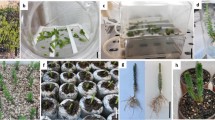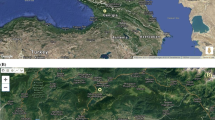Abstract
In order to optimise tissue culture systems and to meet production targets, Mondi Forests’ biotechnology programme has in the last 2 years concentrated efforts on the use of the RITA® temporary immersion bioreactor system. Protocols have been established for six Eucalyptus clones. Results indicate a four- to six-fold increase in yield, in half the time, with the RITA® system when compared with axillary bud proliferation on semi-solid media. Furthermore, plants produced from the RITA® system are hardier and acclimatize better, giving higher yields of hardened-off plants. The establishment of aseptic axillary shoots into the RITA® system is from shoots in the semi-solid system. Highest multiplication was achieved using 30-second flushes of medium every 10 min, starting with 50 shoots per vessel. The multiplication cycles in RITA® are between 14 and 18 days, compared with 25–28 days in a semi-solid system. There is minimal callus evident on the leaves and bases of the stems of plants in the RITA® system and, in addition, cold-tolerant plants have a greater rooting competence when compared with plants coming from the semi-solid system. Ex vitro rooting of RITA® – derived plantlets is substantially better than the plants from the semi-solid media.
Similar content being viewed by others
Abbreviations
- BAP:
-
6-benzylaminopurine
- EC:
-
electrical conductivity
- IBA:
-
indole-3-butyric acid
- MS:
-
Murashige &Skoog (1962) medium
- NAA:
-
α-naphthaleneacetic acid
References
J Aitken-Christie T Kozai S Takayama (1995) Automation in plant tissue culture. General introduction and overview J Aitken-Christie T Kozai MAL Smith (Eds) Automation and Environmental Control in Plant Tissue Culture Kluwer Academic Publishers Dordrecht 1–18
A Akula D Becker M Bateson (2000) ArticleTitleHigh-yielding repetitive somatic embryogenesis and plant recovery in a selected tea clone, ‘TRI-2025’, by temporary immersion Plant Cell Rep. 19 1140–1145
D Alvard F Cote C Teisson (1993) ArticleTitleComparison of methods of liquid medium culture for banana micropropagation Effects of temporary immersion of explants. Plant Cell Tiss. Org. Cult. 32 55–60
M Berthouly H Etienne (2002) Temporary immersion system: a new concept for use of liquid medium in mass propagation First International Symposium on Liquid Systems for In Vitro Mass Propagation of Plants Cost 843 Working Group Aas Norway 37–38
CG Borroto (1998) ArticleTitleTemporary immersion bioreactor systems reduced micropropagation costs Agri cell Rep. 30 IssueID1 2
AC Cassells (1997) Pathogen and microbial contamination management in micropropagation–an overview AC Cassells (Eds) Pathogen and Microbial Contamination Management in Micropropagation Kluwer Academic Publishers Dordrecht 1–13
D Cornu MF Michel (1987) ArticleTitleBacterial contaminants in shoot cultures of Prunus avium L choice and phytotoxicity of antibiotics. Acta Hort. 212 83–86
NP Denison JE Kietzka (1993) ArticleTitleThe use and importance of hybrid intensive forestry in South Africa SA For. J. 165 55–60
M Escalona JC Lorenzo B González M Daquinta JL González Y Desjardins CG Borroto (1999) ArticleTitlePineapple (Ananas comosus L Merr) micropropagation in temporary immersion systems. Plant Cell Rep. 18 743–748
H Etienne (2000) ArticleTitleDirect sowing of temporary immersion-produced somatic embryos Agri Cell Rep. 34 IssueID3 17–18
H Etienne M Lartaud N Michaux-Ferrière MP Carron M Berthouly C Teisson (1997) ArticleTitleImprovement of somatic embryogenesis in Hevea brasiliensis (Müll Arg) using the temporary immersion techniques In Vitro Cell. Biol. 33 81–87
K Fujiwara T Kozai (1995) Physical micro-environment and its effects J Aitken-Christie T Kozai MAL Smith (Eds) Automation and Environmental Control in Plant Tissue Culture Kluwer Academic Publishers Dordrecht 319–369
EF George (1993) Plant Propagation by Tissue Culture. The Technology Vol. 1 Exegetics Ltd Edington 612–635
DP Holdgate EA Zandvoort (1997) Strategic considerations for the establishment of micro-organism-free tissue cultures for commercial ornamental micropropagation AC Cassells (Eds) Pathogen and Microbial Contamination Management in Micropropagation (pp Kluwer Academic Publishers Dordrecht 15–22
YK Ikemori (1987) ArticleTitleEpicormic shoots from the branches of Eucalyptus grandis as an explant source for in vitro culture Comm. For. Rev. 44 351–356
MB Jackson (2002) Ventilation of plant tissue cultures. First International Symposium on Liquid Systems for In Vitro Mass Propagation of Plants Cost 843 Working Group Aas, Norway 56–57
E Jiménez N Pérez Feria M de R Barbón A Capote M Chávez E Quiala JC Pérez (1999) ArticleTitleImproved production of potato microtubers using a temporary immersion system Plant Cell Tiss. Org. Cult. 59 19–23
Roux JJ Le Staden J Van (1991) ArticleTitleMicropropagation and tissue culture of Eucalyptus: a review Tree Physiol. 9 435–477
JC Lorenzo LB González M Escalona C Teisson P Espinosa C Borroto (1998) ArticleTitleSugarcane shoot formation in an improved temporary immersion system Plant Cell Tiss. Org. Cult: 54 197–200
P Martre L Dominique D Just C Teisson (2001) ArticleTitlePhysiological effects of temporary immersion on Hevea brasiliensis callus Plant Cell Tiss. Org. Cult. 67 25–35
T Murashige F Skoog (1962) ArticleTitleA revised medium for rapid growth and bioassays with tobacco tissue cultures Physiol. Plant 15 473–496
R Phillips SM Arnott SE Kaplan (1981) ArticleTitleAntibiotics in plant tissue culture: rifampicin effectively controls bacterial contaminants without affecting the growth of short-term explants cultures of Helianthus tuberosus Plant Sci. Lett. 21 235–240
W Preil T Hempfling (2002) Application of temporary immersion system in propagation of Phalaenopsis. First International Symposium on Liquid Systems for In Vitro Mass Propagation of Plants Cost 843 Working Group Aas, Norway 47–48
MAL Smith LA Spomer (1995) Vessels, gels, liquid media and support systems J Aitken-Christie T Kozai MAL Smith (Eds) Automation and Environmental Control in Plant Tissue Culture Kluwer Academic Publishers Dordrecht 371–404
SMA Zobayed J Armstrong W Armstrong (2001) ArticleTitleMicropropagation of potato: evaluation of closed, diffusive and forced ventilation on growth and tuberization Ann. Bot. 87 53–59
Author information
Authors and Affiliations
Corresponding author
Rights and permissions
About this article
Cite this article
McAlister, B., Finnie, J., Watt, M. et al. Use of the temporary immersion bioreactor system (RITA®) for production of commercial Eucalyptus clones in Mondi Forests (SA). Plant Cell Tiss Organ Cult 81, 347–358 (2005). https://doi.org/10.1007/s11240-004-6658-x
Issue Date:
DOI: https://doi.org/10.1007/s11240-004-6658-x




